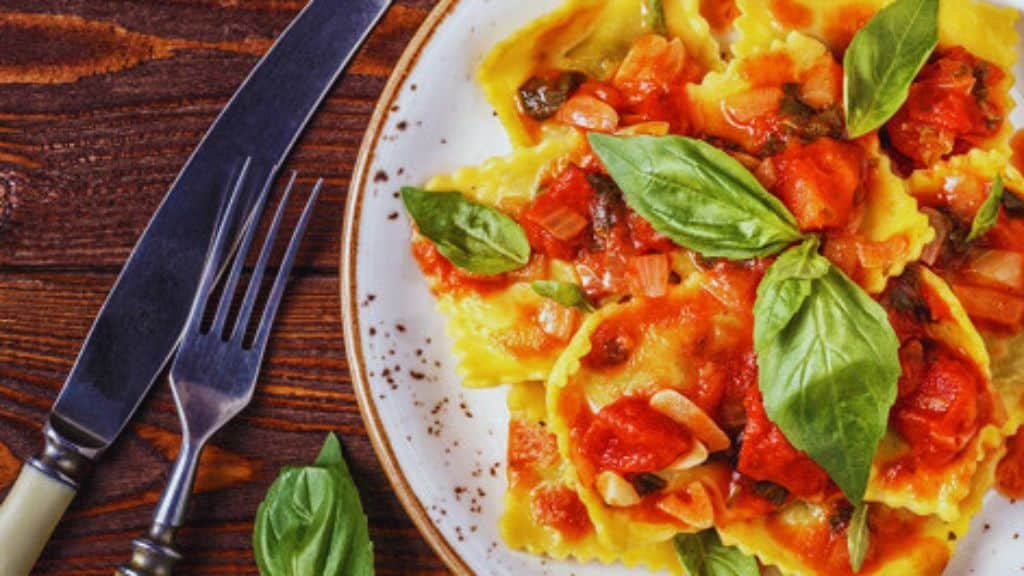Italian food is beloved worldwide for its simplicity, flavor, and rich heritage. With an emphasis on fresh ingredients and age-old recipes, Italian cuisine reflects a tapestry of regional traditions that tell stories of history, culture, and community.
Italy’s culinary diversity is as varied as its landscapes, from creamy risottos in the north to sun-soaked seafood in the south. Join us on a journey through Italian food’s history, dining traditions, regional flavors, and iconic dishes that make it one of the world’s most celebrated cuisines.
The History of Italian Food
Italian food’s roots extend back to the ancient Romans and Greeks, who introduced techniques and ingredients like bread, olives, and wine. As Italy evolved through the Renaissance, so did its cuisine, enriched by spices from the East and newly discovered ingredients like tomatoes and corn from the Americas.
By the 18th century, each region had its own culinary identity, with distinct dishes and cooking techniques that reflected local tastes and available resources. Today, Italian cuisine remains a unique blend of traditional recipes and regional ingredients, often passed down through generations, yet adapted to modern tastes while preserving authentic flavors.
Italian Food Culture and Dining Traditions
Dining in Italy is an experience centered around family, tradition, and celebration. Italian meals are often multi-course, starting with antipasto (appetizers), followed by primo (a pasta or rice dish), secondo (main course, often meat or fish), contorno (side dish), and dolce (dessert). Italians celebrate local, seasonal ingredients and use them generously in their cuisine, with a strong emphasis on freshness and quality.
Food in Italy isn’t rushed; the country’s “slow food” movement encourages people to savor meals, connect with loved ones, and respect the culinary heritage each dish represents.
Related: Turkish Foods
Regional Italian Cuisine: A Tour of Italy’s Culinary Regions
Italian Food is a rich mosaic of regional flavors, each area showcasing its ingredients, techniques, and traditions. From north to south, Italy’s diverse landscapes inspire unique culinary identities.
Northern Italy
Northern Italy’s cuisine is rich and hearty, featuring dairy, butter, and cheese rather than olive oil. Classic dishes include creamy risottos, polenta, and meats, often enhanced with regional specialties like truffles from Piedmont or Parmesan cheese from Emilia-Romagna. Pasta dishes, like pappardelle al ragù, are rich and flavorful, while the northern vineyards produce renowned wines like Barolo and Prosecco.
Central Italy
In Tuscany, Umbria, and Lazio, simple ingredients create big flavors. Olive oil, wine, and herbs dominate this region, with dishes like pasta alla carbonara from Rome and pappardelle al cinghiale (wild boar pasta) from Tuscany showcasing local ingredients. Central Italy is also famous for its cured meats, such as prosciutto and salami, often paired with bread and cheeses for a light, delicious meal.
Southern Italy
Southern Italian cuisine is vibrant and full of sun-ripened flavors, heavily reliant on tomatoes, olive oil, fresh herbs, and seafood. This region is home to iconic dishes like pizza from Naples, pasta alla norma from Sicily, and eggplant parmigiana. Southern Italian food features bold flavors and uses local ingredients like capers, olives, and seafood, reflecting the Mediterranean influence on its cooking.
Islands of Italy (Sicily and Sardinia)
Italy’s islands, Sicily and Sardinia, have unique culinary traditions influenced by Greek, Spanish, and Arabic cultures. Sicilian dishes often feature seafood, citrus fruits, and sweet treats like cannoli and cassata, while Sardinian cuisine includes specialties like fregola (a unique pasta) and porceddu (roasted suckling pig), often enjoyed during festivals and family gatherings.
READ: Lebanese Food
Iconic Italian Dishes You Must Try
Italian food is renowned for its iconic dishes, each bursting with flavor and history. From fresh pasta to creamy risottos, these must-try classics showcase Italy’s passion for simple, quality ingredients.
Pasta
Italian pasta is world-famous, with each region producing its own unique styles. Dishes like spaghetti carbonara, lasagna, and fettuccine alfredo have become global icons. In Italy, pasta is prepared with great care, focusing on complementary sauces and fresh ingredients, such as in Liguria’s pesto alla genovese or Naples’ classic spaghetti alle vongole (clam pasta).
Pizza
Perhaps Italy’s most iconic dish, pizza originated in Naples. Traditional Neapolitan pizza is simple, with a thin, chewy crust, fresh tomatoes, mozzarella, and basil, while Roman-style pizza has a thinner, crispier base. With countless varieties and toppings, Italian pizza continues to evolve, but it always emphasizes quality ingredients and precise techniques.
Risotto
Risotto, especially risotto alla Milanese (made with saffron), is a creamy rice dish that originated in northern Italy. Made with short-grain rice like Arborio, risotto is known for its rich, velvety texture, achieved by slow-cooking the rice and carefully incorporating broth. Other variations include seafood risottos from coastal regions and mushroom risottos from Lombardy.
Gelato and Desserts
Italian desserts are indulgent and varied, with favorites like tiramisu, cannoli, and panna cotta. Italian gelato stands out for its creamy texture and intense flavors, often derived from fresh, natural ingredients. Desserts are a must-try, providing a sweet end to any Italian meal.
Bread and Appetizers
Bread is a staple in Italy, and each region has its specialty, from focaccia in Liguria to ciabatta in Veneto. Italian appetizers, like bruschetta (grilled bread topped with tomatoes and olive oil) and grissini (breadsticks), are simple but flavorful, showcasing Italy’s emphasis on quality ingredients.
READ: Venezuelan Food
Top 10 Most Popular Italian Foods and Main Dishes

Italian cuisine is cherished worldwide, offering various flavors, textures, and ingredients. With dishes that showcase Italy’s regional diversity and culinary expertise, Italian food has something for everyone, from pasta lovers to seafood enthusiasts. Here are ten of the most popular Italian foods and main dishes you must try, each representing the authentic flavors that make Italian cuisine famous.
1. Pizza Margherita
Pizza Margherita is perhaps the most iconic Italian dish, originating from Naples. Made with a thin, chewy crust, fresh tomatoes, mozzarella cheese, basil, and a drizzle of olive oil, it’s celebrated for its simplicity and balance of flavors. Named after Queen Margherita of Savoy, this pizza captures the essence of Italian ingredients in every bite.
2. Lasagna
Lasagna is a classic Italian pasta dish made with layers of flat pasta sheets, rich meat or vegetable sauce, creamy béchamel, and cheese. Originating from the Emilia-Romagna region, lasagna is baked until golden and bubbling, making it a comforting favorite worldwide. Variations include vegetarian lasagna and unique regional takes featuring different meats or cheeses.
3. Spaghetti Carbonara
Spaghetti Carbonara is a beloved Roman dish made with spaghetti, eggs, Pecorino Romano cheese, black pepper, and guanciale (cured pork cheek). This creamy pasta dish has no cream added, relying on the emulsified egg and cheese mixture to create its rich texture. Carbonara’s simplicity and depth of flavor make it a staple of Italian cuisine.
4. Risotto alla Milanese
Risotto alla Milanese is a creamy, flavorful rice dish from Milan, known for its distinctive yellow color, thanks to saffron. Made with Arborio rice, butter, onion, white wine, and Parmesan cheese, it’s stirred continuously to achieve a smooth, creamy texture. Risotto alla Milanese is often served with ossobuco, a Milanese specialty of braised veal shank.
5. Ravioli
Ravioli are small, square pasta pockets filled with various ingredients such as ricotta cheese, spinach, or meat. These filled pasta dumplings can be served in a simple butter and sage sauce, with tomato sauce, or even in a light broth. Ravioli variations are found throughout Italy, with each region offering unique fillings and sauces.
6. Fettuccine Alfredo
Fettuccine Alfredo is a creamy pasta dish originally created in Rome, consisting of fettuccine noodles tossed with butter and Parmesan cheese. The heat from the pasta melts the ingredients into a creamy sauce. Although the dish has become more elaborate in other countries, traditional Italian Alfredo remains simple, relying on quality ingredients for its flavor.
7. Ossobuco alla Milanese
Ossobuco alla Milanese is a hearty main dish featuring braised veal shanks cooked in a rich sauce of white wine, broth, vegetables, and herbs. Often served with risotto or polenta, ossobuco is tender and flavorful, with marrow at the center of the shank bone that’s prized for its creamy, rich texture.
8. Parmigiana di Melanzane (Eggplant Parmesan)
Parmigiana di Melanzane, or Eggplant Parmesan, is a popular dish made with layers of fried eggplant, tomato sauce, mozzarella, and Parmesan cheese, all baked to perfection. Originating in Southern Italy, this vegetarian dish is savory, comforting, and rich in flavor, often enjoyed as a main course.
9. Gnocchi
Gnocchi is soft, pillowy dumplings made from potatoes, flour, and egg, though variations exist using semolina or ricotta. These versatile dumplings are enjoyed throughout Italy and can be served with a variety of sauces, from simple tomato and basil to sage butter or pesto. Gnocchi’s texture and flavor make it a comforting and adaptable dish.
10. Tiramisu
Though not a main course, Tiramisu is one of Italy’s most popular desserts and deserves a spot on this list. Made with layers of coffee-soaked ladyfingers, mascarpone cheese, eggs, sugar, and cocoa powder, Tiramisu is a rich and creamy treat with a delightful hint of coffee. Originating in the Veneto region, it’s become a favorite dessert around the world.
READ: Nigerian Food
Italian Wine and Pairing with Food
Italy’s wine culture is integral to its cuisine. From the robust reds of Tuscany, like Chianti and Brunello, to crisp whites from the Veneto region, Italian wines are celebrated for their quality and flavor. Wine is carefully paired with dishes to enhance both the food and the drink, such as serving a Barolo with a rich meat dish or pairing Prosecco with light appetizers. Italian spirits like Limoncello, Amaretto, and Grappa are also popular after-dinner drinks, each bringing unique flavors to complement the meal.
Why is Italian Foods So Famous?
Italian food is famous worldwide for its simplicity, fresh ingredients, and rich flavors. Its appeal lies in the use of high-quality, seasonal ingredients like tomatoes, olive oil, and fresh herbs that create delicious yet approachable dishes. Italian cuisine also celebrates regional diversity, with each area of Italy contributing unique recipes and culinary techniques, from Northern risottos and rich meats to Southern pasta dishes and seafood.
Italian food traditions, such as family-style dining and “slow food” practices, add a cultural richness that resonates globally. Finally, iconic dishes like pizza, pasta, and gelato have become staples in many countries, bringing a taste of Italy to kitchens and restaurants around the world.
Tips for Enjoying Authentic Italian Food
To enjoy Italian cuisine at its best, seek out authentic dishes in local Italian eateries or, if visiting Italy, dine in traditional osterias and trattorias. Ordering by region can enhance your experience, as each area specializes in certain dishes, like seafood on the coast or hearty meats in the north. When cooking Italian food at home, prioritize fresh, high-quality ingredients like olive oil, fresh tomatoes, and aged Parmesan, and keep recipes simple to let the natural flavors shine.
Conclusion
Italian food is more than a cuisine; it celebrates family, culture, and the love of quality ingredients. Italian cuisine offers endless variety, from creamy risottos and hearty pasta to the bold flavors of southern Italian seafood. Whether enjoying a classic pizza in Naples or savoring fresh gelato in Florence, Italian food continues to captivate taste buds worldwide with its simple, flavorful approach to cooking. So next time you sit down to an Italian meal, savor each bite and remember—you’re tasting centuries of tradition, passion, and culinary artistry.
To Know More: Honduran Food
Frequently Asked Questions (FAQs) about Italian Food
Italian food is loved worldwide for its rich flavors, regional diversity, and culinary traditions. Here are some frequently asked questions about Italian cuisine to help you understand and enjoy it even more.
What are some must-try Italian dishes?
Iconic Italian dishes include pasta (like spaghetti carbonara and lasagna), pizza (especially Neapolitan-style), risotto, tiramisu, cannoli, and gelato. Each region offers unique specialties worth trying.
How is Italian pizza different from American pizza?
Italian pizza, especially Neapolitan pizza, has a thin, chewy crust and simpler toppings like fresh mozzarella, tomatoes, and basil, focusing on high-quality ingredients. In contrast, American pizza often has a thicker crust and a wider variety of toppings.
What makes Italian pasta different from other pasta dishes?
Italian pasta is made with carefully selected wheat and is often paired with simple, fresh sauces that highlight high-quality ingredients. Italian pasta shapes and sauces are thoughtfully matched to balance texture and flavor.
What is the typical Italian meal structure?
Traditional Italian meals are multi-course, starting with antipasto (appetizers), followed by primo (pasta or risotto), secondo (main course, often meat or fish), contorno (side dish), and ending with dolce (dessert).
What is the difference between gelato and ice cream?
Gelato is denser than ice cream and has a smoother, creamier texture due to its lower fat content and churning process. It’s also served at a slightly warmer temperature, which enhances its flavor.
How does Italian food differ by region?
Northern Italy focuses on creamy risottos, polenta, and meats, Central Italy is known for olive oil, pasta, and truffles, and Southern Italy specializes in tomatoes, olive oil, seafood, and bold flavors.
What is the importance of fresh ingredients in Italian cuisine?
Fresh ingredients are central to Italian cooking, as they provide the foundation for simple, flavorful dishes. Italian cuisine emphasizes seasonality and locally sourced ingredients, which enhance the natural flavors of each dish.















